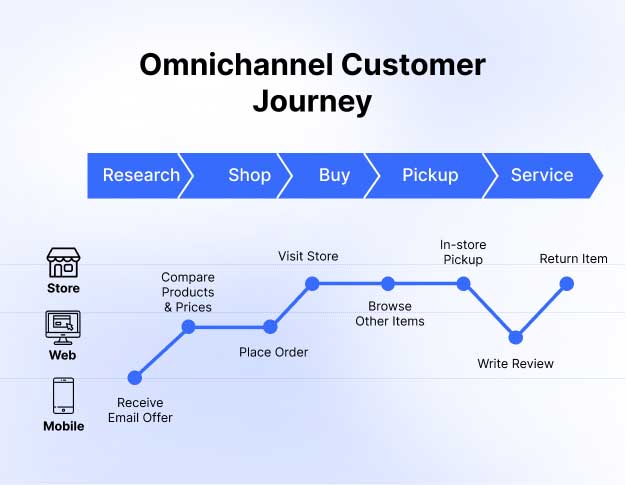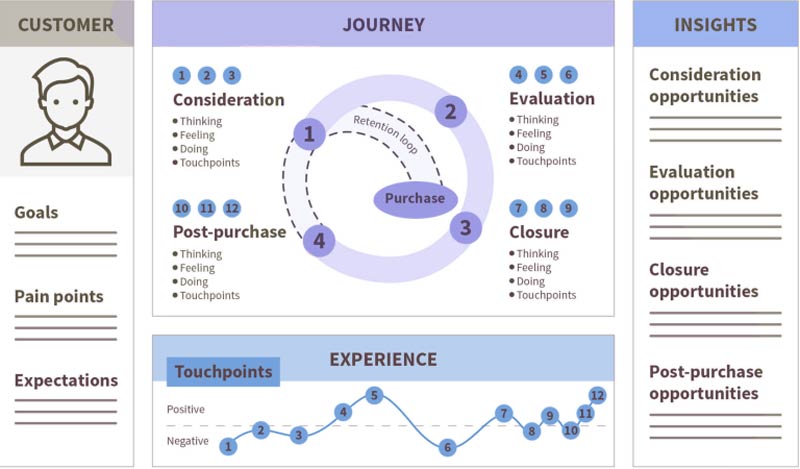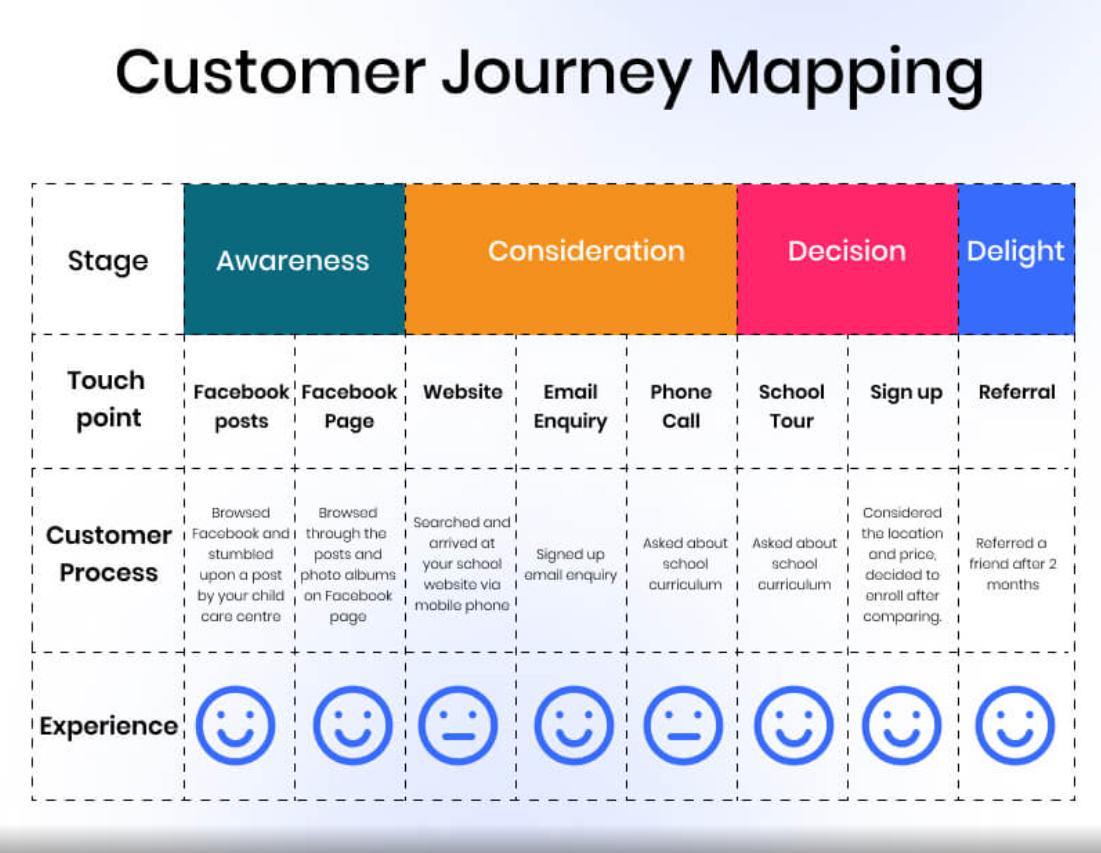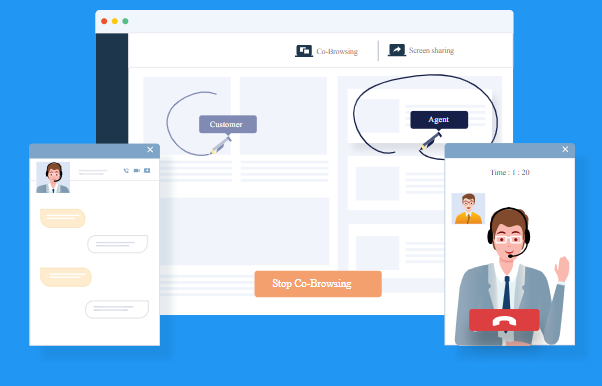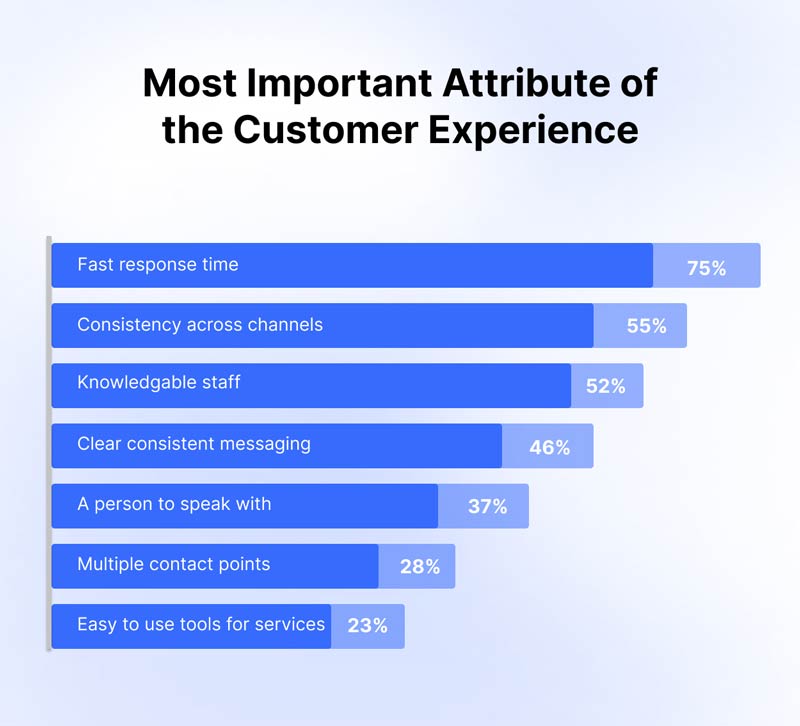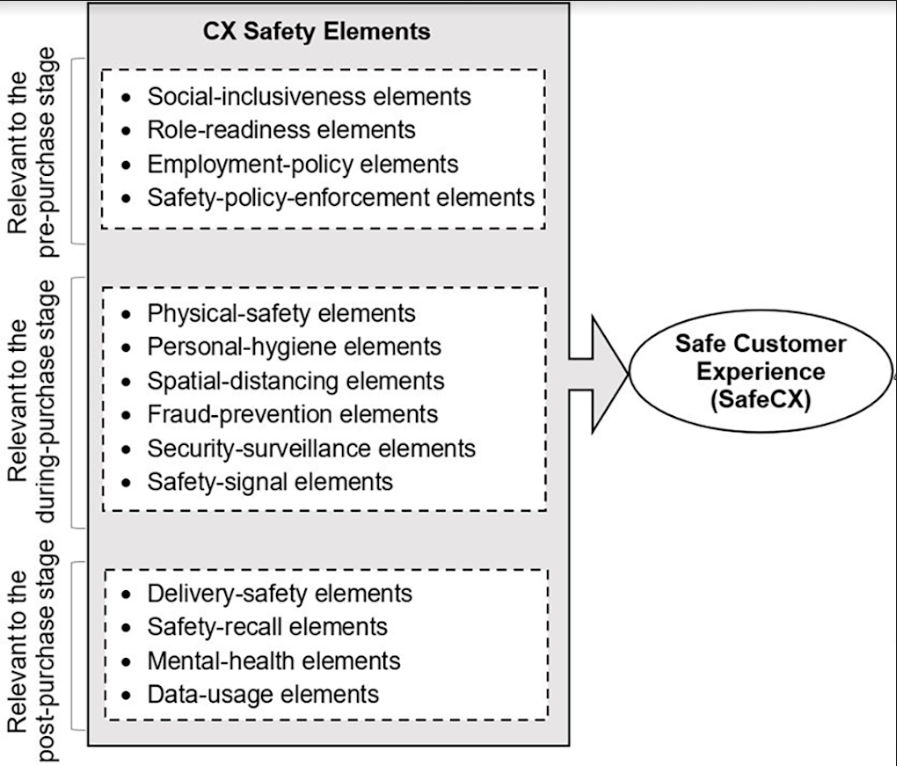Do you envision creating a 360-degree view of the customer to accurately predict and anticipate customer needs?
Or, do you see creating an effortless experience that delivers a consistent experience as it transitions across multiple touchpoints and provides both added value and access to a live agent?
It’s natural to start creating an omnichannel customer journey with vision.
Once a business has a vision, they jump right to functional requirements, skipping the important step of defining the actual customer experience.
It is critical that you consider how to design a memorable experience in the customer journey that maps to the needs of your particular segment and aligns to your brand values.
Every customer expects a seamless experience — regardless of the device or communication channel they choose. They are more likely to choose a brand that has invested in the customer journey over brands that create frustrating service experiences.
9 out of 10 consumers want an omnichannel experience with seamless service between communication methods.
Hence, it is vital to integrate omnichannel communications into an integrated, seamless platform. Let us discuss what is an omnichannel customer journey and how to create & optimize it effectively.
What is Omnichannel Customer Journey?
An omnichannel customer journey is defined as the one that assimilates multiple communication channels. The journey begins with the very first interaction a customer has with your organization and ends when that customer stops doing business with you.
It involves interacting with and engaging customers on their preferred channels, creating a seamless, end-to-end customer journey regardless of the combination of touchpoints a customer uses to engage with your business during the point of sale and throughout their lifecycle.
When businesses gain comprehensive understanding of the omnichannel customer journey, it becomes easier to harmonize the marketing and customer service efforts across interaction channels, while keeping customer needs in prime focus.
Key reasons why businesses should adopt a customer journey omnichannel model
- Clear Perspective of Customer Journey: Having an omnichannel model for customer journey gives businesses a bird’s-eye view of every stage. It streamlines all the interactions across multiple channels under one platform and gives insights into the actions for improving your business.
- Increase Customer Retention: Focusing on omnichannel customer journey allows customers to reach out to a brand via their preferred channels with a smooth transition in the same interaction. It levels up satisfaction rate and acts as an effective customer retention strategy.
- Higher Customer Lifetime Value (CLTV): An omnichannel customer journey model simplifies getting in touch with the company and delivers consistent experience all the time that eventually increases customer lifetime. Omnichannel customers are 30% more valuable to your business over the course of their lifetime.
- Surge Customer Satisfaction: The seamless and personalized omnichannel experiences you deliver based on user mapping lead to higher levels of customer satisfaction. As customers are being heard and responded to in a way that feels right for them. When customer satisfaction increases, so does your company’s revenue.
How to Create An Effective Omnichannel Customer Journey
In order to deliver a great omnichannel customer experience there are different strategies. Implementing the right strategy, siloed engagements can be avoided. Businesses that invest in omnichannel customer service plans witness higher customer satisfaction and retention.
Here is a quick list of the strategic ways of creating a successful omnichannel customer experience management model.
1. Research Extensively on Buyer Personas
“Personas are the starting point,” says Michael Hinshaw, CX strategist.
Because a journey map is the story of a customers’ experience – it explains what happens along the way. Personas represent the customers whose journeys we are mapping.
Buyer personas play an important role in the overall customer journey mapping process, it is vital that organizations create valuable personas that provide a robust platform upon which to build the maps.
A good customer persona typically consist of five parts:
- Goals & Objectives – What is your persona trying to do, why and by when?
- Motivations – What are the key triggers and hindrances? What influences their thinking?
- Behaviors – Where do they find information? Is your persona spontaneous or do they research and plan every detail? What media channels do they like to use?
- Profile – Think about your persona’s demographics. It can also be useful to think about variables like price sensitivity, confidence with technology and amount of leisure time and whether your persona over- or under-indexes on them.
- Quotes & Photos – Bring your personas to life. It is important that they are stereotypes that feel real so give them a name, add comments captured through research and photos of what they look like.
The best part of a buyer’s persona is that they help in making omnichannel customer journeys smoother in the following ways:
- Enhance value propositions that align with the customer expectations.
- Boost business profits by providing customers with what exactly they are looking for.
- Provide a better understanding of buyers, their needs, and how to fix them.
- Accelerate lead generation by aligning teams around a customer-centric vision.
2. Map Your Customer Journey
Nearly 70% of online shoppers abandoned their cart. Why does a customer spend hours adding products to their cart just to close the tab?
It is likely because you lack a clear grasp of the customer’s journey to purchasing your product or service. You also fail to understand the difference between a buyer journey vs customer journey. The omnichannel customer journey includes every moment a customer interacts with your brand across every touchpoint.
Documenting these moments sequentially yields a sort of map, known as a customer journey map, that can be used to better understand the obstacles customers face in achieving their goals.
Customer journey maps are often divided into distinct phases to help differentiate between otherwise similar types of interactions.
The different phases include:
- Awareness and acquisition: This phase is all about discovery. Customers coming across an ad for your business, visiting your website, calling your contact center all qualify as part of the awareness phase. Customers who commit to making a purchase enter into the acquisition phase, which then connects with the onboarding phase.
- Onboarding and engagement: This phase involves all interactions meant to guide new customers via the purchasing process, including details on how to get the most out of your product or service. It leads to the engagement phase which focuses on interacting closely with customers once they are more acquainted with your brand.
- After-purchase support: This customer journey phase includes the interactions that happen after a customer’s purchase such as reaching out to customer support via phone, visiting your company’s self-support portal or knowledge base, and contacting customer service via email, social media, or any other channel.
3. Identify the Touchpoints Most Preferred
Touchpoints are the key to understanding your customer’s journey. They are basically the place where customer interactions occur.
On an average it takes seven interactions with your brand before the final purchase. Based on such interactions, customers usually create a first impression of the overall brand.
By identifying customer touchpoints, it’s possible to cultivate loyalty and improve customer experience. When you map your customer journey across multiple channels and connect them, it helps you understand customers and their requirements better.
It also enables you to gain a better understanding on how your customers are feeling at each stage of the buying process and through different channels.
How identifying touchpoints help to optimize your omnichannel customer journey model?
- Understand customers and engage them the way they want – learning about the preferred touchpoints helps to be actively available across the channels for real time assistance.
- Personalize your interaction with clients – You can personalize your interaction at the identified touchpoints and create excellent customer service experience examples.
4. Employ Right Tools for Omnichannel Customer Engagement
Did you know that 87% of customers think brands need to work harder to provide a seamless shopping experience?
A customer ought to spend more when there is a significant number of channels available along their customer journey.
Ideally, it is difficult to deliver seamless experiences across diverse touchpoints without the right technology to enable it. Moreover, building the right technology model to provide excellent experience across channels is vital to deliver hassle-free omnichannel user experience.
For any customer to be able to switch between the mobile app and chatbot conversation conveniently, businesses need to use the right digital tools that allow data flow at ease in real-time, to serve customers on their preferred touchpoints.
Some tools that can be used at different touchpoints for creating a great omnichannel customer journey model.
- Chatbots – REVE chatbots can be built and deployed easily to engage customers 24×7 and provide real time answers for simple queries.
- Live chat – Deliver real time assistance to the sales and support related queries with live chat and boost customer satisfaction.
- Visual engagement tools – Using the co-browsing tool to collaborate with customers in real time helps in guiding through complex issues and improve first contact resolution (FCR). With a video enabled call center, you can identify issues faster and deliver personalized solutions.
REVE Chat’s omnichannel customer engagement platform offers a complete suite of digital tools and chatbot solutions to engage customers in real time round the clock. Sign up today with REVE Chat and offer hyper personalized customer experience.
The above mentioned digital engagement tools empower support agents to provide real time response, and effective solutions. You can also strengthen your customer relationships and increase brand loyalty.
5. Scrutinize Customer Feedback Regularly
Getting a handle on how customers view your product, support, and the company is invaluable.
Customer feedback is essential to guide and inform your decision making and influence innovations and changes to your product or service. It brings in golden opportunities that can help you to improve the omnichannel customer journey.
It is also essential for measuring customer satisfaction among your existing customers.
Delivering superior service means delivering real time support by being where your customers are and giving them an easy way to share feedback.
Omnichannel approach empowers brands to engage with customers via every channel and capture feedback at every touchpoint. The different ways to ask for customer feedback are website, social media, emails, in-app, reviews, etc.
Here is how analyzing customer feedback can help to set successful omnichannel customer journey example
- Rightly use feedback to develop an in-depth understanding of customers (their needs, pain points, wants, expectations) to serve them better.
- Implement a proper system to help you collect feedback, analyze it, and act on a regular basis.
- Reduce friction significantly and resolve your customers’ complex problems and challenges.
6. Balance Automation & Human Support Wisely
Another important aspect of omnichannel customer experience is balancing automation and human understanding in the balance proportion.
Customers expect brands to understand them with both intelligent technology along with empathetic human experiences.
Choosing the right approach needs a comprehensive understanding of using live chat vs chatbot by learning the pros and cons of both channels.
Having a balanced support approach of both options manages the resources on priority tasks.
It is recommended to use chatbots as the primary contact for customer interaction and use human support for complex conversations.
Designing both for a great customer service experience helps to maintain the right balance that eventually turns to be the real differentiator for the brand.
Figuring out when a conversation needs to shift from a bot to a human is how the balance manifests – For example, knowing when to please the angry customer with an apology versus an offer or so.
7. Perform a Thorough Gap Analysis
Offering customers seamless, consistent, omnichannel experiences at all customer journey stages is essentially table stakes.
Performing a comprehensive analysis to identify the gaps in fragmented experiences is a vital part of improving omnichannel customer experience.
Brands putting efforts to create a seamless omnichannel customer journey is always a work in progress as customer habits keep evolving.
Today, social media is one of the major platforms to provide immediate assistance to customers while also scoring brownie points in full view of the entire customer community.
Evaluating the gaps will give you valuable insights into what actually your customers are looking for and take the right action steps of improvement to deliver a better omnichannel customer journey experience.
It is recommended to keep a close eye for any data related gaps between various channels, as that may force customers to refer to different sources or channels.
8. Implement Customer Journey Analytics
Customer Journey Analytics allows you to bring your customer data from any channel you choose — both online and offline.
Businesses are increasingly benefiting from customer journey analytics across marketing and customer experience, as the results are real, immediate and have a lasting effect.
Customer journey analytics is a whole new approach to analytics that involves having a journey-based mindset and becoming customer-obsessed. Learning how to choose the best journey analytics platform is just the beginning.
The most powerful benefit of using customer journey analytics is that it connects individual customer behavior to important quantitative metrics and KPIs that you and your business are measured by.
The key lies in selecting the right metrics and KPIs to monitor and improve, based on the insights generated by your journey analytics platform. Some key customer metrics are:
- Net Promoter Score (NPS),
- Customer Satisfaction Score (CSAT) or
- Customer Effort Score (CES)
9. Provide Self Service Options
Research shows businesses lose nearly $75 billion a year in revenue due to poor customer service.
Creating self service options can be highly effective during the customer journey. Hence businesses are investing to develop self-service portals for improving the overall brand experience.
As customers expect immediate answers to their queries. In fact, response time is the most important attribute of the customer journey experience.
Self-service portals provide customers with instant access to information and save time and business resources. 67% of customers prefer to use self-service options instead of speaking with a company representative.
Businesses can create tutorials, manuals, how-to videos to help customers to solve their problems on their own.
Here is how self service portals are an important part of the omnichannel customer journey.
- Use personalized information – Such portals can maintain a record of the products or services purchased and display what is relevant to them. You can identify customer issues and take key steps to address them.
- More positive recommendations – The self service portals help to strengthen brand credibility by creating positive client interactions.
- Educate customers – These portals also help to broaden your customers’ knowledge & skills they require for solving other similar issues in the future.
10. Offer a Safe Customer Experience
Omnichannel retailers had to evolve dramatically during the peaks of COVID-19 to comply with public safety policies to raise customer confidence in shopping across all channels.
As the market looks beyond the pandemic, omnichannel customers not only want an excellent customer experience, but they also want a safe customer experience.
Focusing on omnichannel retailers and their customers, the latest research on safe customer experience (Safe CX) provides a framework for enhancing customer safety and overall CX in post-pandemic omnichannel retailing.
As illustrated in the SafeCX framework below, the study identified fourteen safety elements in omnichannel retailing.
These safety elements are classified into three broad categories: safety elements relevant to CX at the pre-purchase stage, during-purchase stage and the post-purchase stage of the customer journey across all channels.
The SafeCX framework positions the fourteen safety elements into relevant categories:
- Four elements are relevant to the CX at the pre-purchase stage of the customer journey: social inclusiveness, role readiness, employment policy and safety policy enforcement.
- Six elements are relevant to the during-purchase stage of the customer journey: physical safety, personal hygiene, spatial distancing, fraud prevention, security surveillance and safety signal.
- The remaining four elements are relevant to the post-purchase stage of the customer journey: delivery safety, safety recall, mental health and data usage.
Retail managers could focus on the fourteen safety elements when designing a seamless and safe omnichannel customer journey.
Omnichannel Customer Journey Examples
When building an omnichannel customer engagement strategy, here is the example of brands who have done so successfully:
1. Walgreens
Walgreens, the American pharmacy, health and wellness company created a custom mobile app that makes it easier for customers to refill prescriptions, which they can then pickup in store. Their app also showcases store specific inventory making it easier for customers making a trip to decide which location they should visit.
2. Sephora
Sephora had brought up a brilliant omnichannel customer experience program for stronger relationships between consumers and the brand.
Sephora Beauty Insiders can tap into the Beauty Bag on their phone or desktop and have access to a truckload of data. Consumers can shop, see their favorites list, any of their past purchases, and how many rewards points they have, scan items in store to see other options available online, watch tutorial videos, and find a store near them.
This extremely successful application of omnichannel marketing strategy has nurtured 11 million members, who spend 15 times more money on Sephora.com than the average user.
3. Timberland
Timberland, the US online store has combined convenience of online with the experience of the in-person customer experience through the installation of near field communication (NFC) technology. They created touchwalls in their store, which leads to further information on their shoes.
Customers can then add these to their online shopping list or purchase in-store. In addition, Timberland utilizes a product recommendations engine to gain exposure to lesser-known products based on user preferences
Wrapping Up
Although the mechanisms in play behind the scenes of an omnichannel system might be complex, the overall effect for your users and your business is positive. Creating an effective omnichannel customer journey enhances efficiency and simplifies interactions across the board.
REVE Chat is a great customer communication platform that helps businesses to understand customer pain points, engage them in real time, and deliver a delightful experience that improves their lifetime value. Sign in today and create a smooth omnichannel experience.

